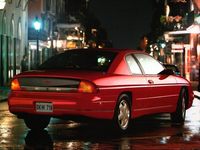New Car Review
1996 CHEVROLET MONTE CARLO LS
By Tom Hagin
SEE ALSO: Chevrolet Buyer's Guide
SPECIFICATIONS
Manufacturer's Suggested Retail Price $ 17,255
Price As Tested $ 19,363
Engine Type 3.1 Liter V6 w/SPFI*
Engine Size 191 cid/2189 cc
Horsepower 160 @ 5200 RPM
Torque (lb-ft) 185 @ 4000 RPM
Wheelbase/Width/Length 107.5"/72.5"/200.7"
Transmission Four-speed electronic
Curb Weight 3324 pounds
Fuel Capacity 16.5 gallons
Tires (F/R) P225/60R16
Brakes (F/R) Disc-ABS/drum-ABS
Drive Train Front-engine/front-wheel-drive
Vehicle Type Five-passenger/two-door
Domestic Content N/A
Coefficient of Drag (Cd.) N/A
PERFORMANCE
EPA Economy, miles per gallon
city/highway/average 20/29/24
0-60 MPH 9.4 seconds
1/4 Mile (E.T.) 17.8 seconds @ 82.3 mph
* Sequential port fuel injection
The Chevrolet Monte Carlo was first introduced in 1970 as Chevrolet's "personal" luxury coupe. Monte Carlo buyers of that year could choose the Super Sport version, with its 454-cubic-inch engine which sported 360 horsepower. Performance perished during the gas crunch of the '70s and the emissions craze of the '80s, and so did the muscular Monte Carlo. The name was dropped in '89, only to be resurrected in '95.
Offered in base LS and sporty Z34 trim, the Monte Carlo offers a quiet ride, soft seating and a feature that's important to the '90s car buyer: a low price and lots of no-cost extras.
OUTSIDE - In the personal coupe segment of the car industry, styling counts more than performance, and the new Monte Carlo's blend of sleek styling, sporty lines and a NASCAR heritage should fare well on the showroom floor. The Monte Carlo of old featured a short trunk and a long hood, and the new version adheres to that styling formula, although it's now more conservative. Monte Carlo LS models come standard with deluxe wheelcovers, but our test model carried the optional 16-inch aluminum wheels and performance-slanted touring tires. Body colored mirrors, door handles and bumpers are also standard equipment. Chevrolet now employs a new "functional build" concept that emphasizes how its parts fit and work together, and was a direct result of the participation of more than 2000 people in Chevrolet consumer clinics. Three new colors are available for 1996, bringing the total to nine.
INSIDE - While the LS model may be the base version, it is equipped with an impressive number of standard features. Standard seating on the Monte Carlo LS is a cloth-covered bench front seat with a 60/40 split and a fold-down center armrest with built-in cupholders. Padding is soft and plush, but not particularly supportive. The rear seat is roomy for two average-sized adults, but the third, middle position is somewhat uncomfortable. Our test model had an optional six-way power driver's seat, while its LS Preferred Equipment Package added cruise control, power trunk release, a cargo net and dual temperature controls. Other standard interior features included a tilt steering column, CFC-free air conditioning, intermittent wipers, and power windows, outside mirrors and door locks.
BEHIND THE WHEEL - Monte Carlo LS is powered by a smooth-running 3.1 liter V6 engine. It produces 160 horsepower, 185 lb-ft of torque, and can deliver up to 29 mpg on the highway. It provides satisfactory motivation for the Monte Carlo, and its just-over nine second 0-60 mph time is enough to move it quickly to freeway speeds. Its quiet growl is pleasant to hear but the engine complains a bit at its upper rpm limits. For those seeking more punch, uplevel Z34 models come with a spirited twin-cam 3.4 liter V6 with 215 horsepower and 220 lb-ft of torque. Both models use an electronically-controlled four-speed automatic transmission that gives imperceptible gear changes. It provides quick downshifts and smooth upshifts, although hard acceleration produces a hint of torque steer, common with most front-wheel-drive vehicles.
BEHIND THE WHEEL - Chevrolet paid particular attention to body stiffness, and added five lateral cross-members to give structural support. Also, a beam spans the width of the car underneath the dashboard to further increase rigidity. The LS is designed to provide a comfortable ride rather than crisp handling. Its MacPherson strut front suspension carries over from the previous-generation Lumina, but its rear suspension is all-new, and much more responsive. It consists of independent variable-rate coil-over MacPherson struts which offer a better ride than before, and standard front and rear stabilizer bars to reduce body roll. Our test run through our impromptu slalom course produced decent handling, although when pushed, the car exhibited heavy understeer and reduced tire grip. Braking is provided by front disc and rear drum brakes, with a four-wheel anti-lock braking system standard.
SAFETY - Dual airbags, ABS and side-impact beams are standard.
OPTIONS - Sixteen inch alloy wheels are $300 while the touring tires added another $175. Our test model carried the Preferred Comfort Package at $403 and six-way power seats added another $300.



